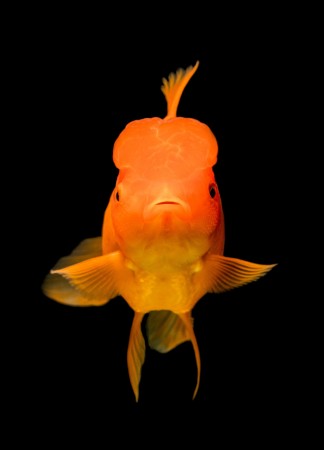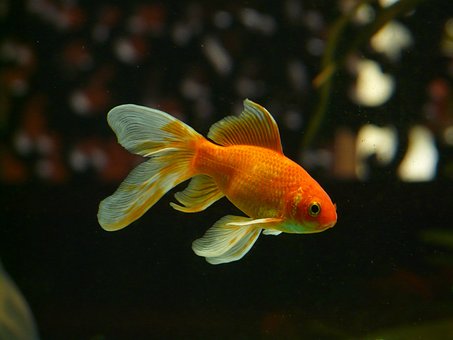The Perfect Goldfish Tank
- Jun 30, 2021
- Rita
- 1443 0 0

Goldfish are one of the most common pet fish around the world. They are excellent starter fish and quite easy to care for. Goldfish (Carassius auratus) is a direct descendant of carp which means they are part of the Cyprinidae family.
It is important to know where goldfish came from if you want to replicate their ideal environment in a tank. Unlike carp, goldfish have been bred to have bright colours and many different appearances. Goldfish can typically be found in slow-moving areas of rivers and even in some ponds and lakes across Asia. They prefer well-vegetated areas so you will need to make sure your tank has enough plants.
You will also need to keep up with water changes and other tank maintenance duties. Goldfish create a lot of waste due to being such voracious eaters. If you can’t keep up, your fish might be better off in a large pond outside.

Types Of Goldfish
There are more than 30 varieties of goldfish. If you’re not sure what you want, the goldfish is an excellent place to start. You can identify the different varieties by looking at their patterns, fin shapes, body shape, eyes, type of scales and other unique features. Here are a few popular varieties of goldfish.
1. Common Goldfish
These fish are fairly inexpensive and is usually the most common pet fish for kids. Common goldfish are also very easy to care for and maintain. They are very popular in outside fish ponds due to how hardy they are.
2. Comet Goldfish
The comet goldfish resembles the common goldfish with the exception of its size and tail. It’s usually smaller than the common goldfish and has a distinct long, pointed tail. They are also easy to care for but needs a bit more space to prevent injury to their tails.
3. Shubunkin Goldfish
Any single-tailed goldfish that is calico coloured is considered to be a shubunkin. This means that the colour of the fish dictates this variety of goldfish.
4. Fantail Goldfish
If you’d like to enter the world of fancy goldfish, then the fantail goldfish is a perfect start. They require more care than the feeder goldfish mentioned above, but they are still fairly easy to care for.
5. Ryukin Goldfish
This fish descends from the fantail goldfish and is used as foundation stock for many other breeds. It is recognised by the noticeable hump on the back. They also have a double tail and are one of the easier fancy variations of goldfish to care for.
6. Ranchu Goldfish
This type of goldfish is one of the oldest breeds in existence today. They are often referred to as the ‘King of the goldfish’. This fish is very valuable in Japan and can be distinguished from the Lionhead goldfish by looking at the less prominent hood and broader back.
7. Lionhead Goldfish
This breed is the most popular dorsal-less goldfish. They sport a beautiful double tail and can be distinguished from the Ranchu by the flatter, less broad back. Due to the lack of a dorsal fin, these fish are quite clumsy swimmers.
8. Oranda goldfish
This breed is often mistaken for a Lionshead. Fortunately, it is fairly simple to tell them apart by looking for the dorsal fin. If a dorsal fin is present, it’s an Oranda Goldfish, if not, it will be a Lionhead. The Oranda is often bred with other varieties of goldfish to create new fancy breeds. They also come in a variety of colour morphs.
9. Pearlscale Goldfish
If you like a unique breed of fish, then the Pearlscale goldfish will definitely appeal to you. They have calcium deposits on their scales that build up to resemble pearls all over their bodies. Unfortunately, they don’t swim very well and thus should be fed floating pellets and occasional bloodworms to keep them healthy.
10. Dragon eye goldfish
Telescopic goldfish with exceptional protruding eyes are often referred to as dragon eye goldfish. They are originally from China but have become increasingly popular in the US.

Tank Size
Your tank size requirement will differ depending on the type of goldfish you have. Some like the comet goldfish may require a tank as big as 75 gallons but the more usual tank size is around 30 to 50 gallons.
Make sure to get the right tank for the type of goldfish you’re thinking of getting. Contrary to popular belief, goldfish don’t stop growing just because they’re in a smaller tank. It is also a good idea to stick to rectangular tanks and avoid the round, tall versions if you’re fish’s wellbeing is important to you.
You will also need to take into account the amount of goldfish you want to keep. You will need about 10 to 20 gallons per goldfish depending on the variety you have. That means if you have a pair of goldfish, you will need a tank as big as 60 to 70 gallons. To get to this number, you will need the starting 30 gallons plus the 10 or 20 gallons per added fish.
Tank Setup
Goldfish need a few things in their tanks to keep them from stressing. They will need ample space to hide so adding logs, plants and other ornaments will definitely fulfil this role. Just make sure to leave ample space for swimming.
You will also need some form of substrate in your tank. Goldfish like to sift through the substrate to find food so make sure you either use sand or gravel larger than the size of a pea. Using smaller sized gravel may be at risk of being swallowed. Swallowed gravel may cause obstructions which will, in turn, cost your fish its life.
Goldfish And Plants
Goldfish are not a type of fish you would want to keep in your pristine, planted aquarium. They are notorious for uprooting plants and will even eat your prized foliage. You can try to keep them in a tank with unpalatable plants like Java Fern and Anubias, but it’s usually easier to just stick with fake plants and other tank decorations.

Water Parameters
Goldfish are coldwater fish that can survive in a variety of conditions. Fancy goldfish are usually a lot pickier when it comes to their water parameters so make sure you know the exact conditions your fish requires.
Temperature: Fancy: 68°- 74°F (20°-23°C) Feeders: 50-70°F (10°-21°C)
pH: Not critical but 7.0 - 8.4 is ideal
Carbonate Hardness: 120ppm ideal
General Hardness: 120-160ppm ideal
Ammonia: 0-0.25ppm ideal
Nitrite: 0ppm ideal
Nitrate: below 20ppm
Tank Mates
The best tank mates for a goldfish are usually more goldfish of the same kind, but they can be paired with other types of coldwater fish. If you don’t want more goldfish, try the following alternatives:
- White cloud mountain minnows
- Hillstream loaches
- Dojo Loach
- Ricefish
- Hoplo Catfish
- Longfin rosy barbs
There are a few more that can be used along with goldfish. The general rule, they have to be peaceful fish and be able to survive without a heater in the aquarium.

By Daiju Azuma at http://opencage.info/pics/ - http://opencage.info/pics.e/large_17158.asp, CC BY 2.5, https://commons.wikimedia.org/w/index.php?curid=77754852
Common Diseases
Goldfish, especially the fancy kinds, are very prone to some diseases. If you’re worried about the health of your fish, contact a veterinarian or fish expert. Most fish diseases are quite simple to treat if caught early on. Here are a few you should be aware of:
- Ich: White spots all over your fish
- Flukes: A parasite that causes bleeding
- Anchor worm: A parasite that is seen when the seasons change - very contagious
- Hole-in-the-head: Common in Lionhead and Oranda goldfish. Causes an ulcer on the head.
- Fin-rot: sores on the fins. Shows up in sick or stressed fish.
- Ulcers: Large growing holes in the body of your fish.
- Cloudy eye: Most common in goldfish with protruding eyes. Caused by injury and infections
There are many more diseases that goldfish can get. The ones mentioned here are just the tip of the iceberg. If you want to keep your fish healthy, make sure to get a big enough tank, do regular water changes and feed the correct food.
If you do everything you can to care for your fish, your goldfish will grace you with their presence from 10 to even 30 years. Be prepared for a long partnership!







About author